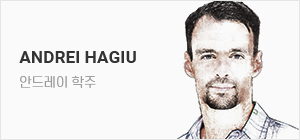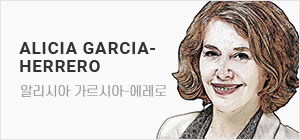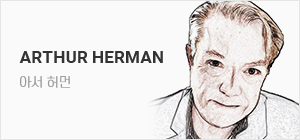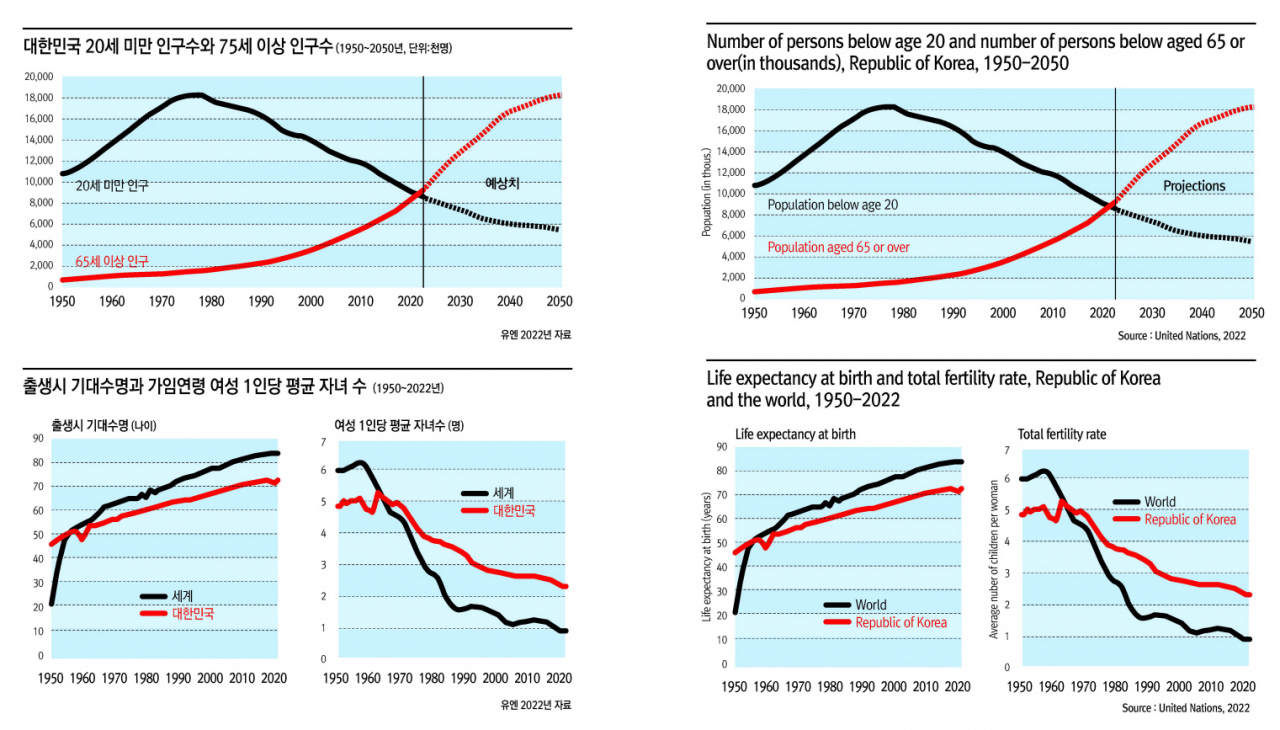 |
| Senior citizens waiting in a long line for lunch in front of the Wongaksa Senior Citizens Free Kitchen at Tapgol Park in Jongno-gu, Seoul, which was open every day even during the Chuseok holiday last year. [Yonhap news] |

The Republic of Korea has undergone a remarkable economic and social transformation, transitioning from an agrarian society to a global economic powerhouse in just two generations. This rapid development has gone hand in hand with significant demographic changes, which have shaped and will continue to shape the country‘s present and future economic, social and environmental outlook.
The demographic transition in the Republic of Korea
In the 1960s, the Republic of Korea was still in the early stages of the demographic transition―the historic shift towards longer lives and smaller families that has been a universal feature of social and economic development . Sixty years later, life expectancy at birth in the country is ranked among the world‘s highest, while the average number of children that a woman is expected to bear during her reproductive lifetime has fallen well below 2.1, the level required to guarantee population replacement in the absence of immigration.
The Republic of Korea, together with other countries in Europe, Asia and elsewhere, is now entering a “post-transitional” stage of the demographic transition, when the number of deaths exceeds the number of births, resulting in a declining population size.
The first demographic dividend and its role in the country‘s development
The rapid decline of fertility experienced by the Republic of Korea has contributed significantly to the country‘s economic growth by generating a temporary increase in the share of population in the working ages compared to the combined share of children and older persons. All other things being equal, a growing share of potential workers leads to a more rapid increase in income per capita ― a phenomenon often referred to as the first demographic dividend. Ensuring that the demographic shift is accompanied by supportive policies in the areas of education, health care and employment allows countries to maximize the associated economic gains.
The Government of the Republic of Korea implemented a range of policies to boost the economic impact of the first demographic dividend, including by investing in health and educational outcomes, promoting the accumulation of physical capital, supporting technological innovation, strengthening institutions and creating opportunities for decent work. Coupled with a favorable age distribution, these measures have contributed to the rapid economic development of the country over the last few decades.
| ||
| 서울의 한 공공산후조리원 신생아실에 일부 요람이 비어 있다. [연합] |
Ultra-low fertility and policy responses
Smaller families have gradually become the norm in almost all regions of the country, reflecting changes in the economic and social costs and benefits of parenting, and in cultural values around families and children. However, as indicated by the latest information released by Statistics Korea for the year 2023, the Republic of Korea stands out for having reached an average number of births per woman of 0.72 ― the lowest in the world.
This ultra-low level of fertility is the product of several factors. As in many countries of Asia, childbearing outside marriage remains rare in the Republic of Korea. Over the last 50 years, however, both women and men have married later, and the postponement of marriage has contributed to the delayed onset of childbearing (United Nations, 2019). In 2022, women in the Republic of Korea were having their first birth at age 33 on average ― on par with, or later than, women in many countries of Western Europe.
In addition to postponing marriage and childbearing, the proportion of women who never marry has also increased significantly. Since 2000, the percentage of women who are single at ages 30-34 has more than tripled, reaching 37.5 per cent already in 2015. In addition to the rising share of women who decide to postpone childbearing, some are choosing to forego it altogether as reflected in increasing rates of childlessness.
Starting in the mid-1990s, the Government of the Republic Korea introduced several policies and programmes designed to encourage family formation and support working parents in having children (Jones, Straughan and Chan, 2009). Since the mid-2000s, the Government has attempted to counter declining birth rates by adopting family-friendly policies, such as parental leave, flexible working arrangements and subsidized childcare services, as well as financial incentives in the form of direct cash transfers, tax breaks and housing subsidies (OECD, 2019). At the same time, the Government has tried to influence traditional gender norms by promoting greater gender equality in the workplace and at home.
The success of these efforts depends on fostering an environment in which women can reconcile their family aspirations with their professional careers. A systematic assessment of the impact of these policies is not yet available. Addressing the social and economic conditions driving ultra-low fertility in the Republic of Korea will likely require major societal shifts.
| ||
| Some cradles are empty in the neonatal room of a public postpartum care center in Seoul. [Yonhap News] |
Opportunities and challenges of an ageing society
Decades of low fertility have contributed to rapid population ageing in the Republic of Korea. Since 2021, persons aged 65 or over have outnumbered those below age 20. Both the number of persons and the share of population at ages 65 and above are expected to double by 2050, reaching more than 18 million and representing 39 per cent of the national population.
Number of persons below age 20 and number of persons aged 65 or over (in thousands), Republic of Korea, 1950-2050
To mitigate the impact of this rapid population ageing on economic growth and to ensure economic security at older ages, it is essential that policy makers use all tools at their disposal. Prioritizing public investments in health care and education for all, including lifelong learning, and eliminating age-related discrimination and barriers to formal employment are some of the critical measures needed for older persons to make continued contributions throughout the life course. Enhancing standards of occupational health and safety, creating conditions for decent work and investing in social protection systems are also critical.
A rapidly ageing society need not elicit pessimism about future economic and social conditions. People reaching older ages today are often in better health and better educated compared to earlier generations, with positive impacts on the economy and society at large. Countries can also seek to reap the benefits of a second demographic dividend, driven by the increasing capital intensity of the economy and a rise in savings among working-age individuals in preparation for retirement in a context of increasing longevity. A rise in savings at older working ages can support a greater accumulation of human and physical capital, faster growth in productivity and a higher national income per capita. Technological progress, including automation, can also be harnessed to boost productivity in an ageing society.
For countries still in the earlier stages of the demographic transition, the experience of the Republic of Korea may serve as a valuable example of how to leverage demographic change to boost economic growth and strengthen national capacities to address the challenges and harness the opportunities of rapid population ageing.
*This column was co-authored by Mr. Thomas Spoorenberg, a demographer and data analyst at the United Nations Population Division
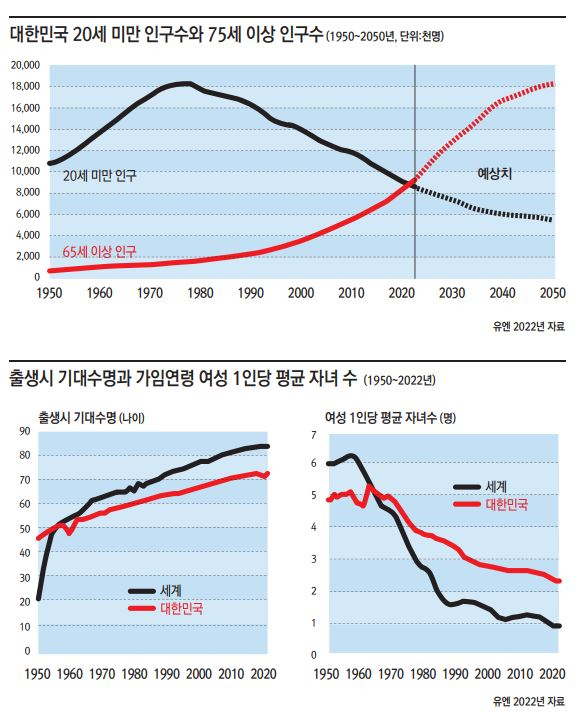
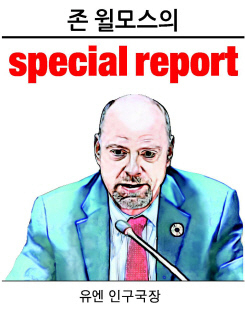
대한민국은 놀라운 경제적·사회적 변화를 겪으며 농업 사회에서 단 두 세대 만에 세계적인 경제 강국으로 변화했다. 이러한 빠른 발전은 인구 구조의 급격한 변화와 함께 이루어졌는데, 이는 대한민국의 현재와 미래의 경제, 사회, 환경 전반에 영향을 미치고 있고 지속적으로 영향을 미칠 전망이다.
대한민국 인구구조의 변천사
1960년대 당시 한국은 아직 인구전환의 초기 단계에 있었다. 인구전환은 사회경제발전의 보편적 특징인 더 긴 수명과 더 적은 가족규모를 향한 역사적 변화를 의미한다. 60년이 지난 지금, 한국의 기대수명은 세계 최고 수준에 도달했으며, 한 여성이 가임 연령 동안 낳을 것으로 예상되는 평균 자녀수는 이민이 없는 상황에서 인구대체를 보장할 수 있는 2.1명을 훨씬 밑돌고 있다. 한국은 유럽, 아시아의 다른 국가들과 함께 이제 인구전환의 ‘전환 이후’단계에 접어들고 있다. 이 단계에서는 출생수보다 사망수가 많아져 인구수가 감소하게 된다.
첫번째 인구 배당과 국가발전에서의 역할
대한민국에서 경험한 급속한 출산율 감소는 근로 연령 인구의 비율이 아동 및 노인 인구의 총합 비율에 비해 일시적으로 증가함으로써 국가의 경제 성장에 크게 기여했다. 다른 모든 조건이 동일하다면 잠재적 근로자의 비율 증가는 인구당 소득의 더 빠른 증가로 이어지는데, 이 현상은 종종 첫 번째 인구 배당이라고 불린다. 인구 변화가 교육, 보건 및 고용 분야의 지원 정책과 동반될 때, 국가들은 관련 경제 이익을 극대화할 수 있다.
대한민국 정부는 첫 번째 인구 배당의 경제적 영향을 증대시키기 위해 보건 및 교육 성과에 대한 투자, 물리적 자본의 축적 촉진, 기술 혁신 지원, 기관 강화 및 적절한 일자리 창출을 포함한 다양한 정책을 시행했다. 이러한 조치들은 유리한 연령 분포와 결합돼 지난 몇 십 년 동안 국가의 빠른 경제 발전에 기여했다.

초저출산과 정책적 대응
거의 모든 지역에서 가족의 규모가 점차적으로 줄어들고 있으며, 이는 부모가 되는 것에 대한 경제적, 사회적 비용 및 혜택, 그리고 가족과 아이들에 대한 문화적 가치의 변화를 반영하고 있다. 그러나 대한민국 통계청이 2023년 발표한 최신 정보에 따르면, 대한민국은 여성 당 평균 출생율이 0.72명으로 세계 최저치에 해당하는 것으로 나타났다.
이 초저수준의 출산율은 여러 요인의 복합적 결과다. 아시아 많은 국가들과 마찬가지로 대한민국에서도 결혼 이외의 출산은 보기 드문 현상이다. 그러나 지난 50년 동안 여성과 남성 모두 결혼을 더 늦게 하고, 결혼의 연기가 출산의 지연에 기여했다. 2022년에는 대한민국의 여성들이 평균적으로 33세에 첫 출산을 하고 있었으며, 이는 서유럽 많은 국가들의 여성들과 동등하거나 그보다 늦은 시기다.
결혼과 출산을 미루는 것 외에도, 결혼을 하지 않는 여성의 비율도 크게 증가했다. 2000년 이후 30-34세 여성 중 미혼인 비율은 2015년에 이미 37.5%를 기록하며 세 배 이상 증가했다. 출산을 미루기로 결정한 여성들의 비율이 늘어나는 것에 더해 무자녀 가정의 증가율로 볼 수 있는 것처럼 일부 여성들은 출산을 아예 포기하기도 한다.
90년대 중반부터 대한민국 정부는 가족 형성을 촉진하고 부모들이 자녀를 낳을 수 있도록 지원하기 위한 여러 정책과 프로그램을 도입했다.
2000년대 중반부터 정부는 출산율 하락에 대응하기 위해 육아휴직, 유연한 근무 제도, 보육 서비스 지원 등 가족친화적 정책을 채택하고, 직접적인 현금 지원, 세제 혜택, 주택 보조금 등 금전적 인센티브를 제공하려고 노력했다. 동시에 정부는 직장과 가정에서의 성 평등을 촉진함으로써 전통적인 성 역할에 영향을 미치고자 노력했다.
이러한 노력의 성공 여부는 여성이 가정에서의 미래계획을 전문적인 경력과 조화시킬 수 있는 환경을 조성하는 데 달려 있다. 이러한 정책의 영향을 체계적으로 평가한 결과는 아직 발표되지 않았다. 대한민국에서 초저출산을 촉발시키는 사회적·경제적 조건에 대처하기 위해서는 큰 사회적 변화가 필요할 것으로 보인다.
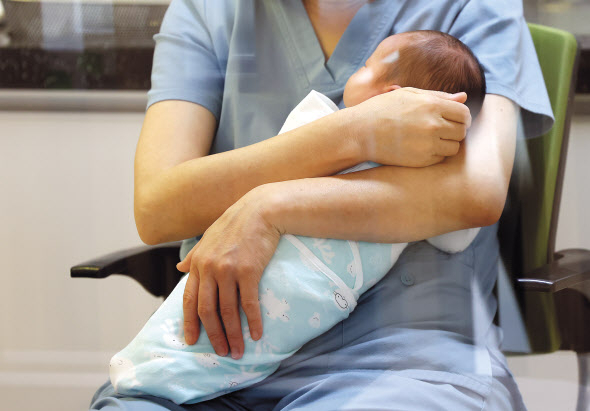
고령화 사회의 기회와 직면 과제
수십 년간의 저출산은 대한민국에서 빠른 인구 고령화에 기여해왔다. 2021년부터 65세 이상 인구가 20세 미만 인구를 초과하기 시작했다. 65세 이상의 인구 수와 인구 비율은 2050년까지 두 배로 증가해 1800만명 이상에 달하고 전국 인구의 39퍼센트를 차지할 것으로 예상된다.
고령화가 경제 성장에 미치는 영향을 완화하고 고령화 시대의 경제안보를 보장하기 위해서는 정책 결정자들이 사용 가능한 모든 수단을 활용하는 것이 중요하다. 전 국민을 위한 건강 관리와 평생 교육을 포함한 교육에 대한 공공 투자를 우선시하는 것이 필요한 중요한 조치 중 일부이다. 고령자가 일생 동안 계속해서 사회에 기여할 수 있도록 연령 관련 차별과 공식적인 고용 장애물을 제거하는 것이 필요하다. 직업 건강 및 안전에 대한 기준을 강화하고 적절한 일자리 조건을 조성하며 사회 보호 체계에 투자하는 것 역시 중요하다.
급속한 고령화 사회에서 미래의 경제적·사회적 상황에 대해 비관적으로만 생각할 필요는 없다. 현재 고령층에 속한 사람들은 종종 이전 세대보다 건강하고 교육 수준도 높아져 경제와 사회에 긍정적인 영향을 미친다. 국가들은 경제의 자본 집중화 증가와 노인의 수명 연장에 따른 노후 준비로 인한 노동 연령층의 저축 증가로 발생하는 두 번째 인구 배당의 혜택을 누릴 수도 있다. 노동 연령층의 노후 준비를 위한 저축 증가는 노동력 및 물리적 자본의 더 큰 축적을 촉진하고 생산성의 더 빠른 성장 및 국민 소득 증대를 가져올 수 있다. 고령 사회에서 생산성을 향상시키기 위해 자동화와 같은 기술적 발전도 기대해 볼 수 있다.
아직 인구구조 변화 초기 단계에 있는 국가들에게는 대한민국의 경험이 인구 변화를 활용한 경제 성장 촉진, 급속한 인구 고령화의 기회 활용 및 직면 과제를 해결하기 위한 국가 능력 강화 등에 대한 소중한 예시가 될 수 있다.
*이 칼럼엔 유엔 인구국 소속 인구학자이자 데이터분석가인 토마스 스푸렌버그가 공동저자로 참여했습니다.
hongi@heraldcorp.com







